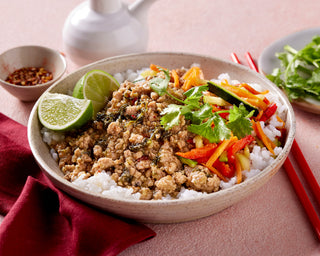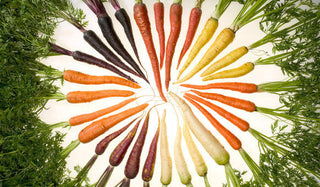They say that inner beauty radiates to the surface. But without a warm complexion, smooth-textured skin and fewer wrinkles, many of us find it difficult to feel our beauty glow. From ancient Egyptian times women have used cosmetics to beautify themselves and through the ages creams and lotions have been the key to youthful skin. But the problem is skin care treatments do not penetrate deep enough to generate healthy skin continuously. In order to nourish the skin, you need to work from the inside out.
Carrots (helps protect against skin cancer)
Carrots are an excellent source of the antioxidant group called carotenoids. The most common one being B-carotene. During prolonged exposure to UV rays, the blood levels of B-carotene decrease to quite low levels which can increase the risk of skin cancer. Studies have shown that by consuming 30mg B-carotene (about 4 carrots) per day for 2 weeks prior to a ‘holiday in the sun’ as well as during sun exposure, concentrations of B-carotene are increased, thus preventing the drop associated with increased cancer risk. This may also increase the reflective capacity of the skin. The combination of more carotenoids in the diet, together with the application of sunscreen appears to enhance the protective effects.
Fish (calms inflammation)
Fish contains valuable dietary compounds for the skin. Fish is a rich source of omega-3 fatty acids that combat free radicals ensuring they do not damage collagen networks within the skin. Omega-3 has the ability to invade areas with infected pimples, helping to reduce inflammation. Some studies have also confirmed benefits for reducing inflammatory skin conditions such as dermatitis and psoriasis. Oily fish such as salmon, mackerel, sardines and tuna are excellent sources of omega 3s and need to be consumed around three times per week to ensure a good intake of omega 3s. If you are allergic to fish or have a dislike for it see the table (below) for alternatives.
Omega 3's
If you are not a fish eater, add one of the following for the omega 3 benefit 150g salmon fillet contains the same amount of omega 3 fats as: — 2 tbsp (40g) walnut oil — 2 tbsp (40g) wheat germ oil — 2 tbsp (40g) soy bean oil — 1.5 tbsp (30g) canola oil — 3.5 tbsp (18g) linseeds — 4 tbsp (60g) walnuts — 1.5 cups (300g) soy beans, uncooked.
Citrus fruit (keeps skin elastic)
These fruits contain two compounds beneficial for skin health - vitamin C and limonene. Vitamin C retains the skin elasticity by reconstructing the collagen network, ultimately helping to reduce loose skin. Preservation of the collagen networks also helps to ensure bruising is reduced. Short-term supplementation with high doses of vitamin C (3g) together with vitamin E (2g) has been shown to reduce the effects of acute sunburn. Limonene, an antioxidant present in citrus fruits (oranges, lemons, limes, grapefruit, mandarins, tangelos), particularly the peel may help to reduce the risk of skin cancer.
Soy (keeps skin youthful)
Phytoestrogens in soy foods eg. soy drinks, tofu, soy and linseed bread have been found to act like the hormone oestrogen. They help to delay the onset of dry skin and wrinkling associated with the ageing process. Another important component present in soy products is vitamin E which boosts new cell growth. Exact quantities of phytoestrogens that need to be consumed to reap the benefits are unknown. However, there are no negatives in including soy products in your diet several times a week.
Wholegrain cereals (eliminates toxins)
The skin is a reflection of internal health. Toxins within the body can potentially result in unhealthy skin. Fibre found in whole grains acts like a purifying system, by filtering the wastes out of the body. This removal helps boost the skin's potential to be healthy and clear. Calcium may also have a role in the removal of toxins. So the combination of a wholegrain breakfast cereal and calcium-rich milk or soy may offer additional benefits. Isovitexin, an antioxidant found in wild rice has been touted as having anti-aging properties for the skin, and is also used by the cosmetic industry.
Tomatoes (fights premature wrinkling)
Tomatoes are the richest source of lycopene which has the potential to decrease collagen damage deep within the skin tissue, the area which can form wrinkles. Many skin creams and treatments now contain lycopene, but there appear to be enhanced benefits by actually eating lycopene-containing foods such as tomatoes, watermelon, guava and pink grapefruit. The redder the tomato the higher the lycopene content and cooking actually increases the level.
Dark green vegetables (rejuvenating skin)
Nutrients in foods like these carry many skin rejuvenating properties. Green leafy vegetables like spinach, silverbeet, Asian greens and dark green salad mix contain the antioxidant, B-carotene (vitamin A precursor) which has the capability to destroy cell-damaging free radicals. Iron present in these vegetables together with the vitamin C ensures oxygen is transported to the skin cells. Iron deficiency can result in large dark circles (bags) forming under the eyes. Broccoli also contains the antioxidant vitamin C, which helps cross-link collagen fibres, therefore, preventing collagen destruction by free-radicals. To enhance the absorption of B-carotene, drizzle a little oil over the vegetables. And remember that overcooking will destroy the vitamin C.
Berries (anti-aging)
Antioxidants called anthocyanins have anti-aging abilities as they are believed to protect the body against chemical carcinogens and ultra-violet light. These are found in berries such as strawberries, blueberries, blackcurrants, raspberries and cranberries. These fruits also contain the anti-oxidant vitamin C, which has the ability to reconstruct damaged collagen. Berries can be consumed all year around. When fresh are not in season try frozen varieties and blackcurrant juice to boost your anthocyanin intake.
Plant and seed oils (healthy glow and reduced dryness)
Oils from olives, nuts and avocados provide the skin with a healthy glow. The essential fatty acids found in these foods reduce clogged pores by thinning out the oils secreted by the pores. Furthermore, it has been suggested that individuals affected with eczema have abnormal essential fatty acid metabolism and may benefit from an adjustment of the types and quantities of the fat in the diet. However, this sort of dietary manipulation is complex. The presence of vitamin E in these oils ensures the production of new cell growth, keeping the skin supple, smooth and moist. The combination of this antioxidant vitamin with others such as b-carotene is believed to protect against erythema (redness of the skin) and therefore may be useful for diminishing sensitivity to ultraviolet light and the effects of sun damage. How much do we need? Including small amounts of these healthy oils in your diet every day would be advisable for healthy skin.
Shellfish (clear skin)
The acne terminator – zinc – found in oysters and other molluscs decreases acne flareups. It also plays a major role in helping breakdown damaged collagen, allowing new collagen to form which in turn rejuvenates the skin, making it look youthful. One of the clinical signs of zinc deficiency is dry, flaky skin. Most people need 12mg of zinc per day – try these foods: ½ dozen oysters (19mg zinc), 100g lean lamb (5mg), 1 bowl fortified breakfast cereal (2mg), 1 cup baked beans (1.5mg), 1 cup cooked spinach (1mg), 1 slice wholemeal bread (0.4mg).
Article written by Karen Inge, and first published on www.kareninge.com.au




